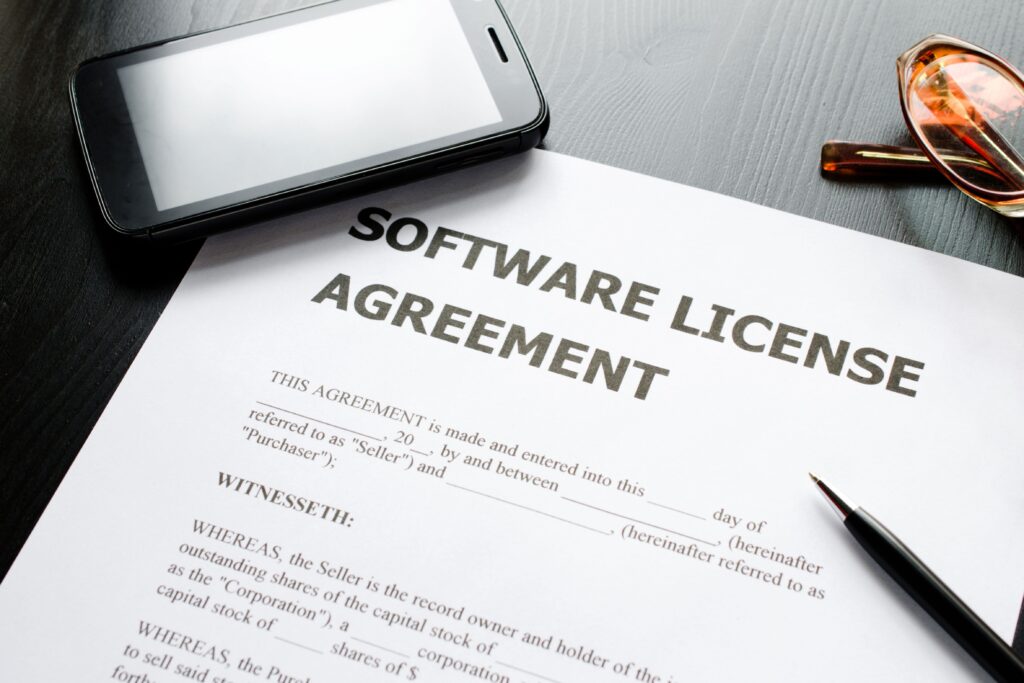Software Licensing: A Knowledge Pill for Entrepreneurs
In today’s business world, software plays a key role in the operations of many companies. However, before an enterprise installs software on its computers, it is important to understand the licensing terms and conditions. In this article, we will discuss key issues regarding software licensing to help entrepreneurs make informed decisions.
Table of Contents:
- Types of Software Licenses
- Rights and Limitations of the License
- Software Purchase and Installation Process
- Consequences of Violation of License Conditions
- Frequently Asked Questions
Types of Software Licenses
Single-Site Licenses
Single-user licenses allow you to use the software on a single computer device. These are traditional licenses in which you acquire the right to use the program on your computer. They allow users to install and use software on a single device in accordance with the terms of the license agreement.
Multi-user licenses
Multi-user licenses allow the software to be used on multiple computers under a single license agreement. They are often chosen by companies that need access to software on multiple workstations. They allow a company to legally install and use the program on different computers in its network, without having to buy a separate license for each device.
Open Source Licenses
Open source licenses allow users to access, modify and distribute source software without incurring additional licensing fees. These are often the choice of programmers and small businesses that want to customize software for their individual needs. Open source licenses promote openness, collaboration and the freedom to create and share software.
SaaS licenses
Software as a Service (SaaS) licenses allow users to use the software over the Internet, usually through a monthly or annual subscription. These are flexible solutions that allow companies to scale their resources as needed. With the SaaS model, users can access the latest versions of the software without having to install or update it themselves.

Rights and Limitations of the License
Each license of the software specifies rights and restrictions on the use of the program. A thorough understanding of the license terms is crucial to avoid illegal use of the software and possible legal and financial consequences. Software licenses may vary depending on the type of program and the vendor, so it is important for each user to read the license before using the application. The terms of the license may specify the number of devices on which the software can be installed, the range of functions available to the user, the conditions for distributing the software, and the possibility of modifying the source code. Adherence to the terms of the software license is crucial for legal use of the program and compliance with the law. Illegal copying, distribution or modification of software can lead to serious legal consequences, including financial penalties, compensation claims and loss of corporate reputation. Therefore, before using any software, it is important to carefully read, understand and comply with the terms of the license.
Software Purchase and Installation Process
The process of purchasing and installing software includes several key steps. First, choose the right product that meets the needs and requirements of the company. It is then necessary to purchase the appropriate license, taking into account the number of users and the range of functions that will be needed. After purchasing a license, you can proceed to install and configure the program. In this step, follow the manufacturer’s instructions and comply with the license terms and conditions to ensure legal and proper use of the software. Once the program is installed, it is necessary to train users to enable them to use the application effectively and take advantage of all its features. The entire process of purchasing and installing the software should be carried out in accordance with applicable legal regulations and with care to ensure data security and system integrity.
Consequences of Violation of License Conditions
Violation of the terms of the software license can result in serious legal and financial consequences and negative consequences for the company’s reputation. If a company is found to be in violation of its license, it could face fines or other financial sanctions imposed by regulators, or even be subject to legal action by the software developer. In addition, the illegal use of software can lead to a loss of trust from customers and business partners, which can negatively affect a company’s image and reputation. Therefore, strictly adhere to the terms of the software license and regularly monitor and update licenses to avoid potential legal and financial consequences.
Frequently asked questions
1. what is a software license?
A software license is a contract between the user and the software developer that specifies the terms of use of the program.
2. what are the most common types of software licenses?
The most common types of software licenses are single-user licenses, multi-user licenses, open source licenses and SaaS licenses.
3. are there free software licensing options?
Yes, there are free software licensing options, such as open source licenses, which allow users to use software without paying licensing fees.
4. how to avoid violating the terms of the software license?
To avoid violating the terms of the software license, carefully read and understand the license terms and follow the manufacturer’s instructions.


